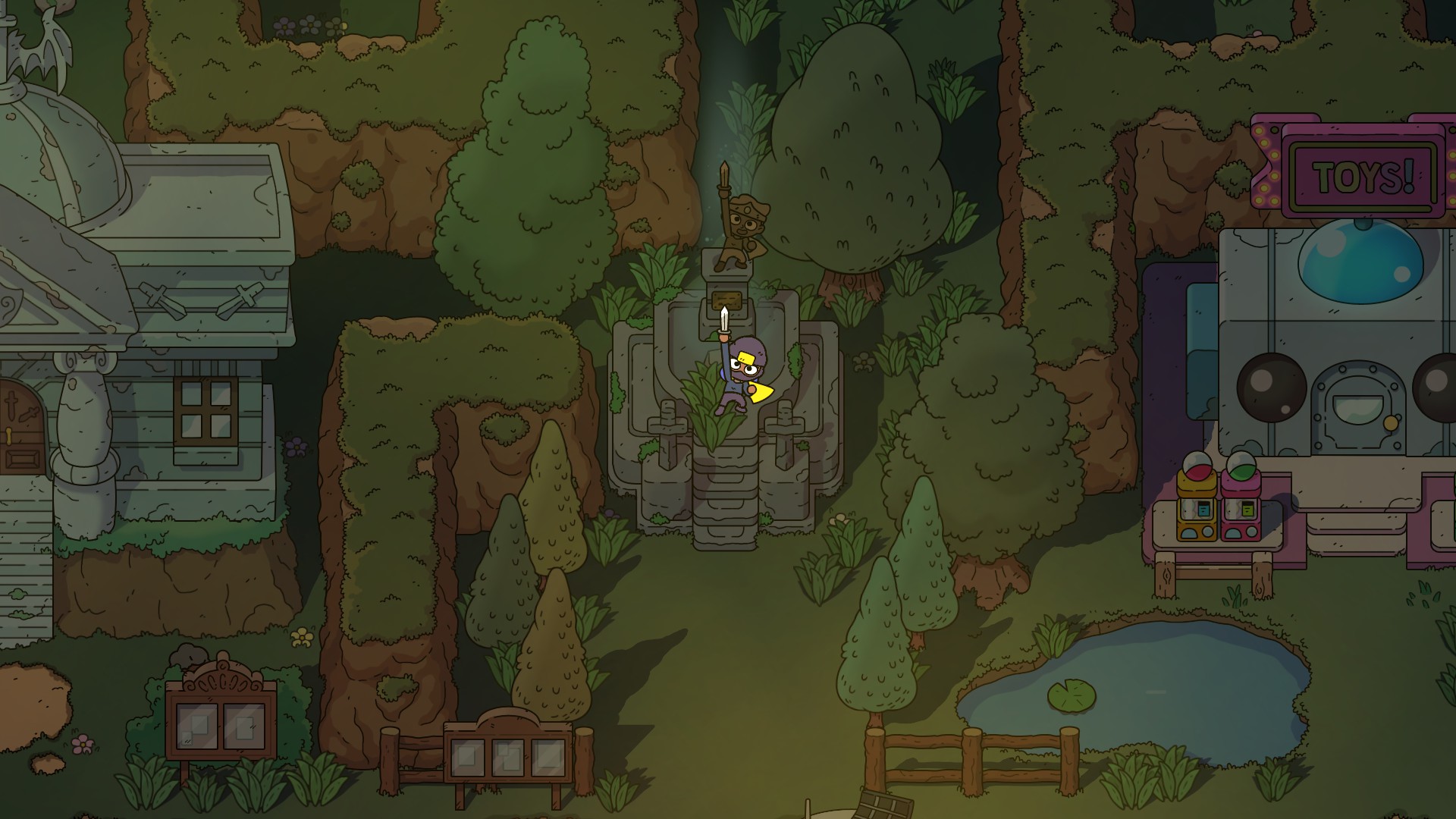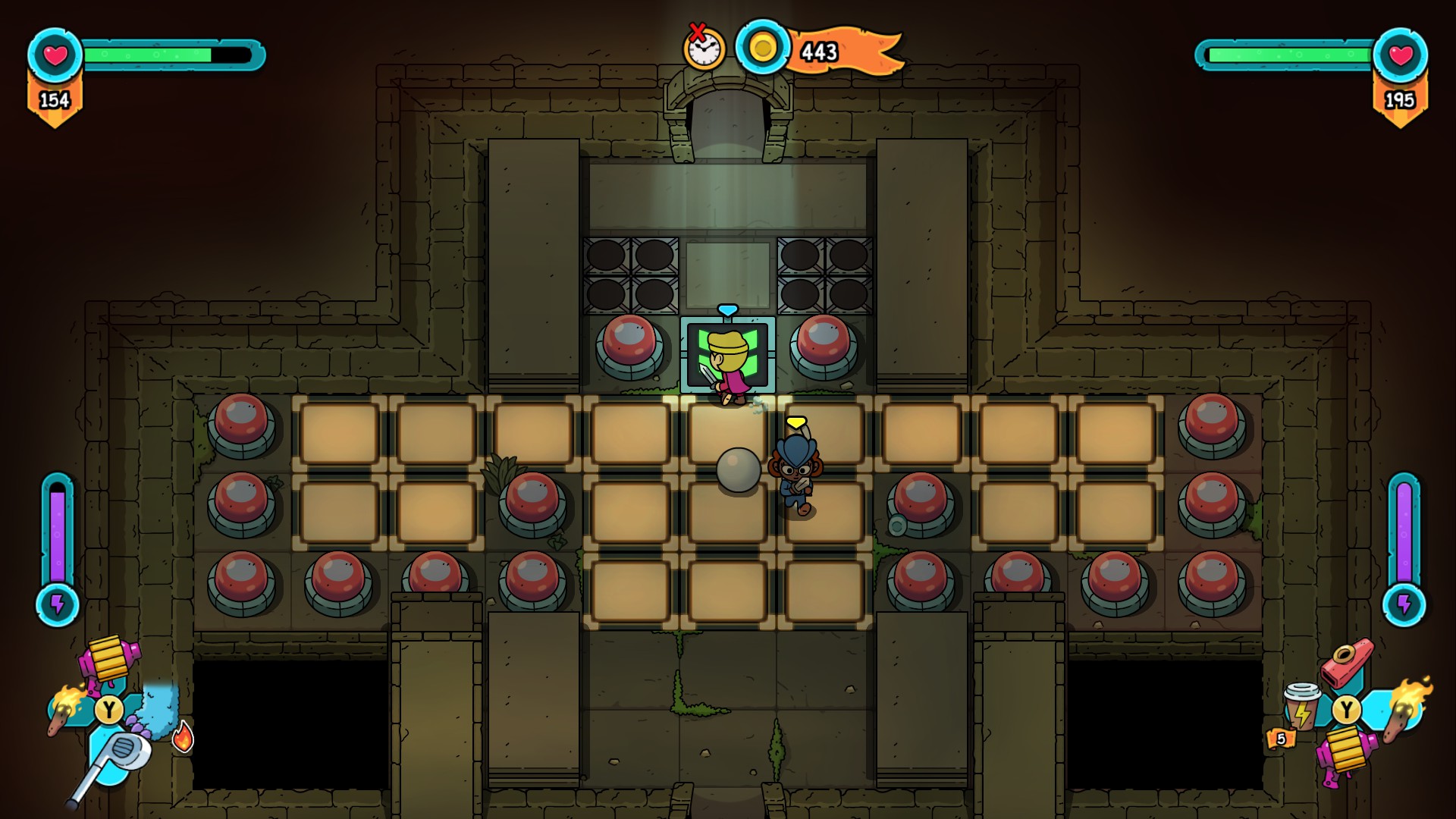

The first time I had a successful “run” in The Swords of Ditto, I thought, “well that was pretty fun, but is that it?” Then, the giant space whale appeared...
I do not envy onebitbeyond trying to market and pitch this title to a broad gaming audience. Phrases like “rogue-lite” or “Legend of Zelda clone” may encapsulate the core gameplay, but they do not speak to everything that is going on in this co-op adventure. There is far more to discover than a 5, 10, or even 30 minute demo would show you, and that’s ultimately a disservice to a title that has more to offer than its cartoon-like aesthetic and action/adventure gameplay would lead you to believe. So, in the interest of being able to talk more in-depth about this curiosity, here’s my pitch (very light spoilers ahead; you can skip ahead to the next page if you want to avoid it):
Imagine playing Legend of Zelda: Link to the Past for the first time. You progress through the initial three dungeons, get the special tools and items that let you take on the wizard Agahnim, and then proceed to the final battle. You successfully beat him, rescue Princess Zelda, everyone's happy, and the game "ends." You get a message that the land is once more at peace and you pass into legend. After that, you receive a message that states this cycle will continue, but you have a means to end it. Then, you wake up as a different version of Link and are informed that Zelda has been taken by Agahnim once again, and you must go rescue her. Wait… didn’t you just do this?
Within the game itself, everything (more or less) feels the exact same as what you just played. Your hero has none of the gear they previously collected, major NPCs repeat dialogue, and it seems like you're just doing the same thing again. As a player, though, that brief message you received at the end of your first playthrough should have planted a little bug in your brain. Maybe there's more going on here. Maybe those mysterious locations you ran past the first time have more functionality than you thought. Maybe you should spend your limited time doing a few things other than fighting the main antagonist…

THAT is what The Swords of Ditto is actually about. Despite the “rogue-lite” tag that’s attached to it, it has very little to do with having an “optimized” run, or completing it in the shortest amount of time, or progressing further into some endless dungeon than you did the last time. “Rogue-lite,” in this case, is genuinely used as shorthand to setup some fundamental mechanics within the game (e.g., progression is reset upon death), and not as a genre pigeonhole. There really isn’t a good genre classification for The Swords of Ditto. It is, for better and worse, a game that uses an intentional repetition of gameplay in order to slowly peel back the layers of what’s happening within the game world and push the player towards the true goal.

That core loop is simple: run around the island of Ditto defeating enemies to level up, collect the “Toys of Legend” to get new abilities and powers, weaken the main bad guy (Mormo) by completing certain objectives, and then confront and (hopefully) defeat her. Excepting the final boss battle, you're only given a certain number of days to do everything, which varies based on your chosen difficulty (six on Easy, three on Medium, and two on Hard). You can temporarily extend that limit (eventually), and time stops altogether when you’re in the main town and in dungeons, but inevitably you’ll confront Mormo.
The final battle is easier if you’ve spent some of that limited time defeating monsters and gaining levels. Every time you level up, your health increases and you unlock slots on your hero where you can apply “Stickers” to boost stats. These Stickers are special items that you either find in chests or purchase from vendors. There are a variety of Stickers to find, but their main benefit is to increase various stats, like attack power, defense, and elemental resists, though a few also add new abilities (like a spin attack) to your repertoire.
Whether you win or lose - and dying at any point in your adventure counts as losing - you’ll start the loop all over again 100 years later as a new protagonist with only your experience level, a couple basic toys, and whatever gold you collected in your previous life (along with another unlockable currency) to your name. Not quite square one, but not too far off. In keeping with the “rogue-lite” shorthand, too, the world itself is randomized. Dungeons, key landmarks, and certain vendors are no longer in the same locations, and the layout and contents of dungeons have changed, too.
While the core gameplay loop is fairly solid and fun, there are a number of small issues that crop up. More than once, I found myself wishing for more fast travel points so I could get to certain areas faster and not waste time moving through the world. Until you discover/acquire certain Toys of Legend, bombs are the only way you can blow open cracked walls in dungeons (something that becomes necessary later on) and your bombs are in very limited supply until you discover a certain NPC. Certain enemies can be difficult to deal with unless you have some specific Toys of Legends, and while that makes for an interesting challenge your first couple encounters, I ended up blowing past them later on unless I had the right tools to deal with them. When you successfully defeat Mormo, you have to repeat the same sequence of intro events (get woken up in your room, go retrieve the sword, go talk to Mormo, go to talk to the people in the town) every single time. The first or second time, fine. The third, fourth, fifth, or sixth? Please let me skip this.
The bigger problem with all of these is that they are not issues you encounter once or twice and move on. You’ll run into these - or your own list of personal gripes - every time you play, and you’ll have to play a lot if you want to figure out what exactly is going on in The Swords of Ditto. Therein lies the game’s biggest problem.
Again, some slightly spoiler-ish discussion here. In my opinion, there is an intriguing hook to The Swords of Ditto: solve the mystery of what’s actually happening in the game and “break the cycle.” That hook, though, doesn’t even become apparent until the first time you beat Mormo, which may be after a few failed runs and several hours of playtime, depending on what difficulty level you choose. Even once you do defeat her and see the giant space whale (that’s not a metaphor), the randomized game world means you may not discover the really interesting bits until your fourth or fifth playthrough. All of that is placing a lot on the player. That isn’t a bad thing, per se, as there’s a great “a-ha!” moment when you realize and discover there’s more than what you see. Without that hook, though, there isn’t much to the game; it is THE thing to keep you playing and if you don’t buy into it, or if you miss it altogether, then it feels like you’ll bounce off this pretty fast if you’re playing alone. Fortunately, two player couch co-op is supported.
From a gameplay perspective, there aren’t a ton of changes when you bring a buddy along. The second player controls their own hero and can freely equip/use anything to which the first player has access. This means all healing items, all Toys of Legend, and all Stickers are shared between you both. Should one of you die in battle, the surviving player can revive the fallen hero with a hug (awww). There is a cost associated with this, however; the reviving player will give the fallen player half of their current life.
While co-op doesn’t radically change the underlying mechanics, having a buddy with you brings about some more conceptual changes. As I mentioned earlier, you don’t have anything other than your own noggin when it comes to figuring out what’s going on in The Swords of Ditto and how to “break the cycle.” Having a buddy there to notice things you might have missed or bounce ideas off of makes that task a little easier. What’s more, there’s a definite social aspect to some of what you uncover; that feeling you get when you discover something new and want to share it with someone. With a co-op partner, it’s easy to turn to them and exclaim “what is going on!?” (I’ve definitely had a few of those moments), and then dive into some theories.
Outside of that, having two people opens up some interesting combos with the Toys and Sticks. For instance, you might equip a Sticker that adds the Fire element to your attacks while your co-op partner equips one that adds Poison. Apply these elements to an enemy causes damage over time, but they’re treated separately so you could inflict an enemy with Fire and Poison at the same time. Or maybe you use the “Giant Foot” toy to stun all the enemies and your buddy uses the “Bowling Ball” toy to finish them off.
I really like what The Swords of Ditto is trying to do with its various ideas even if it’s not always successful in executing them. Unfortunately, it relies a bit too much on the “there is more going on than what you see” hook, which is doubly unfortunate as that idea won’t even come across until you beat Mormo for the first time (personally, I recommend Easy for your first few playthroughs), and even then it relies on the player being interested in that concept. However, if it does manage to get its hooks into you, it will get them in deep.
I am driven, at this point, to know more and solve the bigger mystery at the heart of all this. I am willing to overlook the various issues in order to sate my curiosity. I am reminded of the entire second half of Full Metal Furies that I stumbled upon and that, regrettably to its detriment, was intentionally left hidden. While these things may make it hard to pitch, we need more games like The Swords of Ditto to challenge our notions for what “rogue-lites” and “Zelda clones” can be. For even as it treads familiar ground (over and over again), it also sets us on new paths that are worth exploring.
The Co-Optimus Co-Op Review of The Swords of Ditto is based on the PC version of the game. A code was provided by the publisher for review purposes.